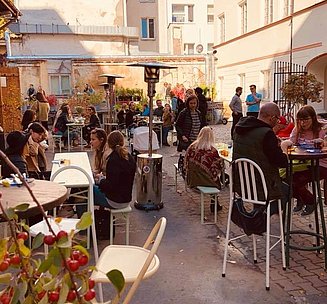UNESCO World heritage, Palace of Culture and Vistula in Warsaw! #places
5 min read#place: Warsaw
Country: Poland
Inhabitants: ca. 1.7 million
Area: 517 km2
Famous Landmarks: Culture Palace
Called also the biggest construction site in Europe, Warsaw is nowadays next to Frankfurt, London, Rotterdam and Paris, one of the highest cities in Europe. The famous Palace of Culture and Science (1955) by russian architect Lew Rudnew is the most famous landmark in the Polish capital and one of Warsaws highrise buildings. The city is home to numerous institutions, universities, theaters, museums and monument and t he historic center is on UNESCO’s World Cultural Heritage List even though it has been almost entirely reconstructed after the World War II total destruction. In summer there are many activities and pop-ups on the banks of the river Vistula.
Architecture
Surrounded by embassies, government buildings and the Royal Park, Jazdów settlement of wooden Finnish houses, also called Finlandia, is one of Warsaw's most expensive grounds. Erected in 1945 as temporary accommodation for architects and engineers rebuilding Warsaw, this settlement, which was owned by the city, remained unnoticed and continued to exist as housing for low-income people. In 2011 there were attempts by the city of Warsaw to demolish the settlement and sell the area. Since then, people living and working here, have been campaigning for the preservation of this settlement as a public living, working and event space. In 27 wooden houses and the adjacent gardens live and act next to each other: residents, non-governmental organizations, urban gardeners and beekeepers, academics and students, artists and workers of businesses, cooperatives, embassies and public institutions.
Address: Jazdów 3/6, 00-001 Warszawa
The museum Katyń houses an exhibition on the Katyń massacre, in which around 4,000 Polish officers were murdered in 1940 by the Soviet secret service NKVD. The museum is integrated into the fortifications of the 19th century citadel. The newly built walls are cast in light red colored concrete, which reminds of the historical fortifications. As with many other "historical-martyrological" museums, symbolic elements complement the exhibition architecturally. The concrete shows the imprints of objects found with victims, such as a uniform button. In 2017, the building by BBGK Architekci was shortlisted for the European Mies van der Rohe Architecture Prize.
Address: Jana Jeziorańskiego 4, 01-521 Warsaw
The Służew Cultural Center by WWAA, 307kilo architects was built in a park on the edge of a modernist prefabricated housing area. Its architecture plays ambiguously on the history of the area, which was a village on the outskirts of the city before the housing development in the 1970s. The property consists of several smaller, wooden-clad buildings, arranged around a common courtyard, giving the impression of a rural farmstead. The main functions of the project and it’s main entrance are placed under ground level, which is accessed by an amphitheatrical staircase from the entrance square. The basin functions as a stage during open-air performances.
Address: Jana Sebastiana Bacha 15, 02-743 Warsaw
Hidden place
The Keret House is only 1.22 meters wide and therefore literally hidden in between the two neighboring buildings. Architect Jakub Szczęsny (Centrala collective) built the smallest house in the world for the israeli writer Etgar Keret. The house is located in the district of Wola, the former Warsaw Ghetto. Keret's mother was smuggled out here as a child and escaped death. In addition to the writer, artists and intellectuals from all over the world are able to use the Keret-Haus as a studio. According to Polish standards, the building is too small for a residential building, it is considered an art installation.
Address: Żelazna 74, 00-875 Warsaw
Bars and Restaurants
The Wozownia Bar is located in an old carriage house and its courtyard behind an old town house on the square of the three crosses. It is a hidden treasure with relaxed atmosphere and offers great food, cocktails and lots of lovable space outside, in the very centre of the city.
Address: Plac Trzech Krzyży 16A, wejście od Nowego Światu, 00-499 Warsaw
The so-called night market - Nocny Market - is located in a side street near the railway museum. From the street you have to go back about 100 meters. The market is outdoors but covered. There are various stands lined up here offering a variety of dishes. The offer is mixed. From traditional Polish dishes such as pierogi or sweet desserts to Thai cuisine to burgers. The backdrop is created by artful and colorful neon lights and music played by a DJ.
Address: Towarowa 3, 01-210 Warsaw
Preparation:
Place the flour on a worktop and form a chop in the middle. Beat in the egg and pour the water over it. Add salt and pepper and knead the dough slowly. Let the dough rest about 15 minutes, then roll out thinly and cut out round circles with a diameter of about 5 cm with a glass or cookie cutter.
Put about 1 teaspoon of the filling in the middle and fold. Press firmly on the edges. Add in boiling, salted water. If the ravioli swim up, cook for another 2 minutes, then remove from the water. Fry in melted butter with breadcrumbs. The Pierogi can also be done with a sweet filling, fruit for example or cheese. Just add little salt and no pepper to the dough.












